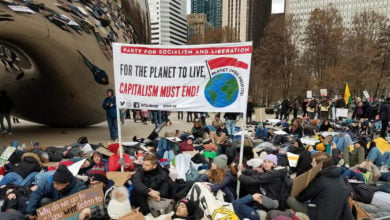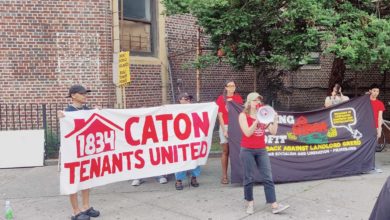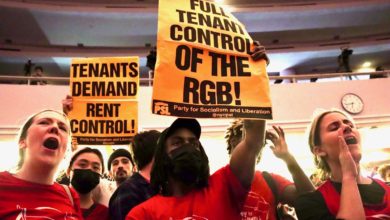As a result of the housing boom, there are now 18 million empty homes in the United States. Yet more than 3 million people are homeless and millions more are currently facing eviction and foreclosure.
A movement is emerging across the country to show another way. Residents, neighbors, and teams of activists are occupying empty and foreclosed homes along with other land to retain and provide housing for poor and working people. These efforts are based on the simple but radical idea that housing must be considered a basic right. This right must come above the ability of landlords and banks to make their profits.
Local battles, national trend
In Miami, the Take Back the Land Movement seized government land in 2006 and held it for a year. The organization created a focal point in the debate about the need for housing. People from all over the city defended and supported the courageous stand, bringing food and supplies to the occupiers. Each shanty structure was named after different revolutionaries, such as Fred Hampton and Mumia Abu-Jamal—sending a message to the police waiting at the doorsteps of the site.
“This started because of the housing crisis in Miami and its particular impact on the Black community with gentrification. Groups have worked on these issues for years without any success. And it turns out that the elected officials and county government have been stealing the money slated for affordable housing. We couldn’t go back to the government, since they were the problem. We had to take back the land,” Take Back the Land Movement leader Max Rameau told Liberation.
In Minnesota in 2009, Rosemary Williams was the seventh person on her block to lose her home from foreclosure. Williams fought back, occupying her home until she was arrested and jailed. She returned with the support of dozens of people who rallied around her—seven people were pepper-sprayed and arrested, but she continued to fight for her home despite the repression of the state.
In East New York, community members and Occupy activists have used creative disobedience tactics to restore evicted families to their homes. As they marched through the neighborhood, they stopped at empty housing units to testify against the banks, landlords and negligent city government. Prior to being evicted, some of the speakers had lived in the homes for decades.
Raising slogans like “No Homes, No Justice,” organizers affiliated with the Occupy Wall Street movement have rallied in cities like San Francisco, Chicago and Los Angeles under the banner Occupy Our Homes. Not only are affected communities taking over property, but they also are repairing abandoned properties and offering space in the neighborhood for people to gather.
From these home occupations, new organizations have emerged to actively fight for a society without homelessness. Seattle, Boston, Atlanta and numerous other cities are seeing a spirited people’s movement against evictions and foreclosures.
A long history of struggle for housing
The growing movement to make housing a basic right is reminiscent of earlier waves of struggle. In the 1930s, radical tenants’ associations and organizations of unemployed workers, often led by the Communist Party, took militant action to secure housing for communities affected by the Great Depression.
These groups organized rent strikes—tenants withholding rent in a building or neighborhood—until landlords fixed their buildings or lowered the rent. They marched into government home relief bureaus and refused to leave until they paid the workers’ rent. They directly moved residents’ furniture back into their homes after the police had evicted them and put their stuff on the street. They would then stand guard to defend these “un-evictions.”
By taking action in such a manner, this housing movement put the landlords on the defensive and made the government wary of the direct conflict that often came with carrying out evictions. As a result of this struggle, as well as the lobbying and protests of industrial unions, city and state governments began creating affordable and rent-controlled housing. These gains were expanded in the next radical upsurge of the 1960s and 1970s.
In the last few decades, as the workers’ movement declined, banks and corporations have taken the political offensive, working hard to reverse every progressive reform. They have rolled back regulation, destroyed rent control, pursued aggressive gentrification, and asserted their absolute property right to evict, foreclose and raise the cost of living on working families.
As the housing crisis continues, generated by the very nature of capitalism, these glowing examples of struggle point the way towards a new movement to make a home a right. As with struggles at the workplace, this form of class struggle can show workers their collective power and become a school for struggle for a whole new society.






